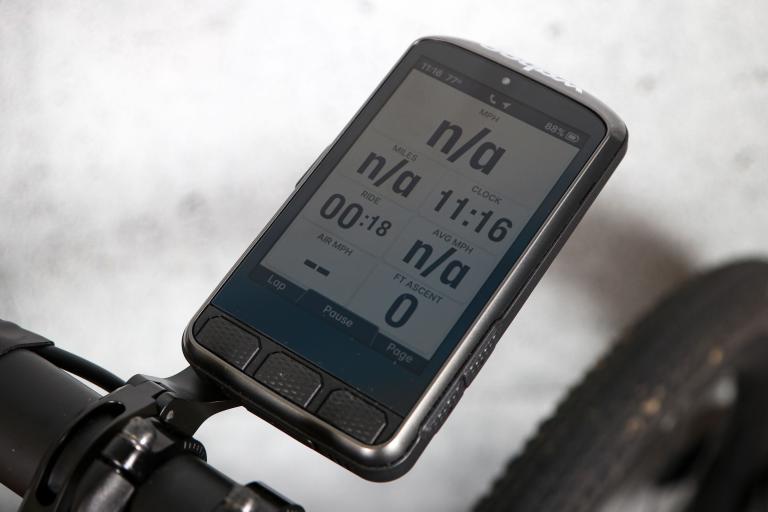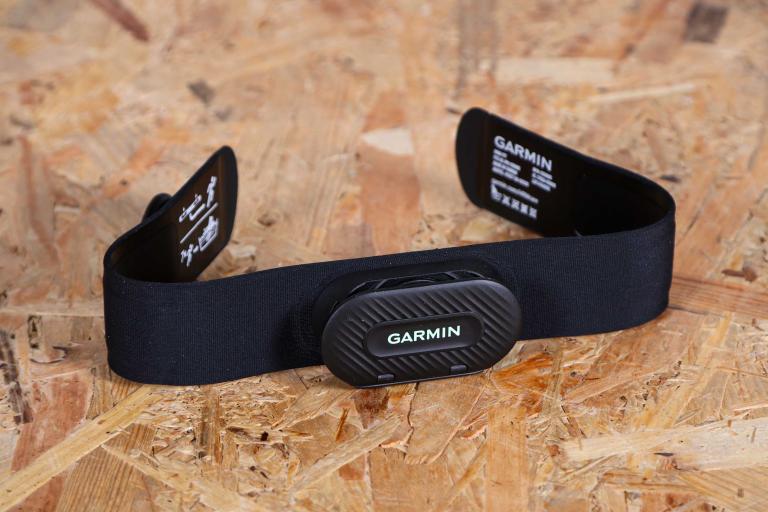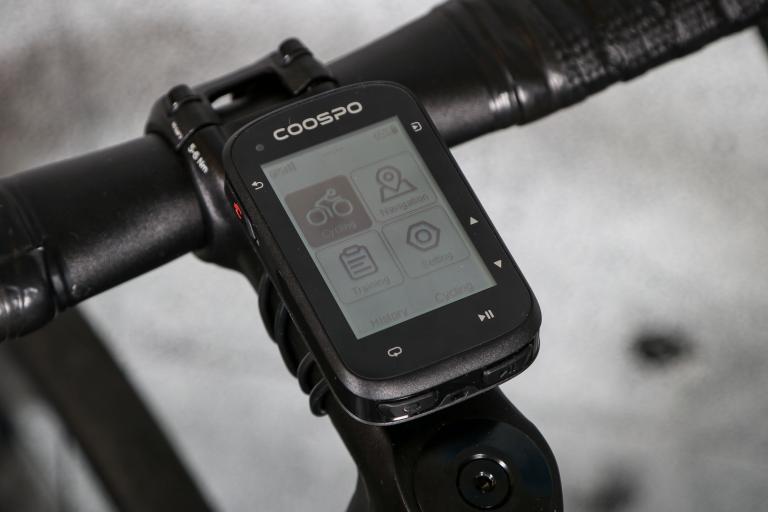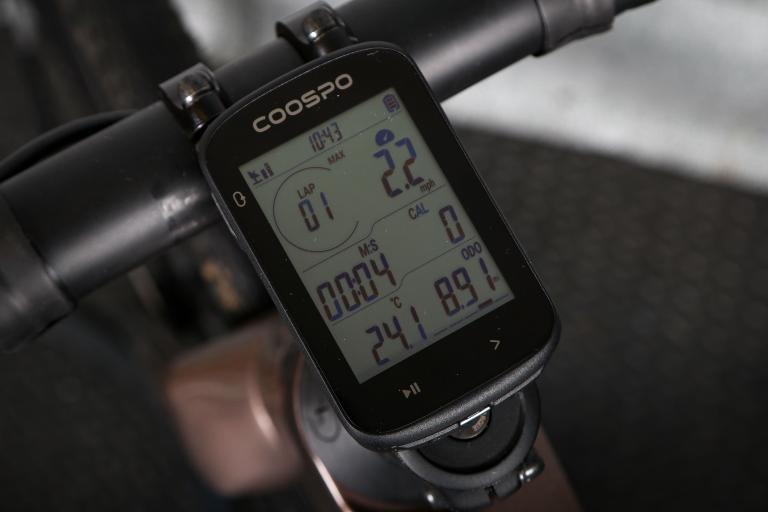- News
- Reviews
- Bikes
- Components
- Bar tape & grips
- Bottom brackets
- Brake & gear cables
- Brake & STI levers
- Brake pads & spares
- Brakes
- Cassettes & freewheels
- Chains
- Chainsets & chainrings
- Derailleurs - front
- Derailleurs - rear
- Forks
- Gear levers & shifters
- Groupsets
- Handlebars & extensions
- Headsets
- Hubs
- Inner tubes
- Pedals
- Quick releases & skewers
- Saddles
- Seatposts
- Stems
- Wheels
- Tyres
- Tubeless valves
- Accessories
- Accessories - misc
- Computer mounts
- Bags
- Bar ends
- Bike bags & cases
- Bottle cages
- Bottles
- Cameras
- Car racks
- Child seats
- Computers
- Glasses
- GPS units
- Helmets
- Lights - front
- Lights - rear
- Lights - sets
- Locks
- Mirrors
- Mudguards
- Racks
- Pumps & CO2 inflators
- Puncture kits
- Reflectives
- Smart watches
- Stands and racks
- Trailers
- Clothing
- Health, fitness and nutrition
- Tools and workshop
- Miscellaneous
- Buyers Guides
- Features
- Forum
- Recommends
- Podcast
review
 Polar CS100 computer
Polar CS100 computer£93.50
VERDICT:
Key racing or training information in one compact wireless package, but you can't upload its data or customise its screens
Weight:
32g
Contact:
www.polaruk.co.uk
At road.cc every product is thoroughly tested for as long as it takes to get a proper insight into how well it works. Our reviewers are experienced cyclists that we trust to be objective. While we strive to ensure that opinions expressed are backed up by facts, reviews are by their nature an informed opinion, not a definitive verdict. We don't intentionally try to break anything (except locks) but we do try to look for weak points in any design. The overall score is not just an average of the other scores: it reflects both a product's function and value – with value determined by how a product compares with items of similar spec, quality, and price.
What the road.cc scores meanGood scores are more common than bad, because fortunately good products are more common than bad.
- Exceptional
- Excellent
- Very Good
- Good
- Quite good
- Average
- Not so good
- Poor
- Bad
- Appalling
In a world of smartphones and ever-cheaper GPS units, Polar's CS100 is old technology: it determines your speed by a wheel magnet rather than satellites, and the only way it will transmit data is into your brain, one toggled screen at a time. These days, when you're spending £90, that feels weird. On the other hand, it's much cheaper than your iPhones and Garmins, especially if you shop around. And sometimes all you really want to know when you're racing or training is your speed, your heart rate, and the elapsed time. That much it will do – and more.
The initial set up is logical but not user-friendly. Remember what it was like setting up a VHS video player? It's like that. I've used plenty of heart rate monitors and bike computers over the years and still had RTFM trouble.
Conversely, it's easy to fit to the bike. The twist-lock bike mount zip-ties to any diameter of handlebar or stem, and the computer goes on and off the mount in a second. The speed sensor zip-ties firmly to the fork and the wheel magnet should fit most spokes. The distance between sensor and magnet is meant to be 4mm or less, though the test sample worked okay beyond that.
Since it's wireless, the fitting hardware is neat. If you want to swap the CS100 between bikes – it supports two bikes at a time, or rather two wheel diameters – that's only practical with extra hardware. An extra speed sensor and twist-lock bike mount will cost £34.20. So if you want to use this on more than one bike, you'll eat into the price differential between the CS100 and GPS computers like Garmins – which can be used on any number of different bikes, with any wheel size, at no extra cost.
The CS100 will display all the usual measurements, such as heart rate (current and average), speed (ditto), distance (trip and total), lap times, time of day, calories burned (a very rough estimate), as well as things like whether you're above or below your average speed, whether you're in your target heart rate zone, and so on. By default, the CS100 sets heart rate zones using 220 minus your age, so it's better to set these manually.
You get three lines of information at a time, one of which is always heart rate. The two main tiers of the display use big, easy-to-read numbers. The top line is much smaller and is difficult to decipher when you're riding on the rivet. While there are different screen options, you can't customise them. It's frustrating if you want an unsupported mix of data.
The CS100 records more data than you can display at once, of course. When you get home you, the only way to log this is to do it manually. You can't transmit it to a home computer or to the internet. The Polar UpLink Tool merely allows you to send settings to the bike computer from your home computer, once you've downloaded the relevant software. It's Windows PC only, so it's too bad if you've got a Mac.
On the bike, however, the CS100 works well. You can operate the buttons even with winter gloves. The computer is rainproof and mine never lost its signal. The chest strap doesn't seem to have any problems picking up your heart rate – with one caveat. Spit on the chest strap is seldom enough. To guarantee pickup, you need to remove the battery compartment and hold the relevant bits of the strap under running water. (The manual recommends this.) A soggy strap around your chest is okay if you're going on the turbo but it's a rude beginning to a winter's ride.
There's an optional cadence sensor for another £26.95. That would make the CS100 almost as expensive as the CS200cad, so if you want to monitor your pedalling revolutions, you're better off buying that. It's much the same as the CS100, except that it also links to Polar's online training diary (www.polarpersonaltrainer.com) via a Windows PC... and only a Windows PC.
As for the CS100, I'm in two minds about it. On one hand, it gives you all the data you really need for training or racing and it is less than half the price of a Garmin Edge 500 – or less than a third if you get a good deal. But to get the most from it, in terms of performance and value, you need to: be happy with the display options; plan to use it on one or at most two bikes; be prepared to log its data manually. All three rule it out for me. So while it is decent entry-level computer/HRM, I'd save up for a Garmin Edge 500 instead or else make do with a Polar FT1 heart rate monitor (about £30 online) and a cheap stopwatch. Your mileage may vary.
Verdict
Key racing or training information in one compact wireless package, but you can't upload its data or customise its screens
road.cc test report
Make and model: Polar CS100 cycle computer
Size tested: n/a
Tell us what the product is for, and who it's aimed at. What do the manufacturers say about it? How does that compare to your own feelings about it?
Polar say: 'For recreational cyclists who want to improve their cycling performance.
Measures heart rate combined with current, average and maximum speed
Determines daily personal heart rate target zones for optimal training
Displays calories burned.'
I say: Not just for starting cyclists. Its main limitation for more experienced cyclists is what you can do with the data.
Tell us some more about the technical aspects of the product?
Computer unit runs off CR2032 battery, chest strap off a CR2025 battery. Sensor battery is not user serviceable.
Rate the product for quality of construction:
8/10
Rainproof. Buttons are sufficiently large.
Rate the product for performance:
6/10
Rate the product for durability:
7/10
Rate the product for weight, if applicable:
7/10
Nice and light. The main unit is 32g. The sensor weighs 17g. I didn't weigh the chest strap.
Rate the product for comfort, if applicable:
7/10
Strap is comfortable but needs to be soggy for HR pickup.
Rate the product for value:
7/10
It's not bad, but GPS devices are getting cheaper and cheaper. And if you've already got a suitable smartphone, it could be just as cheap to get a bluetooth chest strap and a relevant app.
Tell us how the product performed overall when used for its designed purpose
It feels more like a budget buy for more experienced cyclists than a beginner's bike computer.
Tell us what you particularly liked about the product
All in one HRM/computer. Not too expensive.
Tell us what you particularly disliked about the product
Unintuitive set up. Awkward/costly to move between bikes. Having to toggle through screens to get the information I wanted. No data transmission.
Did you enjoy using the product? Sometimes. Sometimes not.
Would you consider buying the product? No.
Would you recommend the product to a friend? Maybe.
Anything further to say about the product in conclusion?
It works fine, within its limits. It's just not for me.
About the tester
Age: 42 Height: 1.78m Weight: 65kg
I usually ride: Ridgeback Solo World fixed wheel My best bike is: Planet X Pro Carbon Track (with front brake)
I've been riding for: Over 20 years I ride: Every day I would class myself as: Experienced
I regularly do the following types of riding: time trialling, cyclo cross, commuting, touring, club rides, sportives, general fitness riding, fixed/singlespeed, mtb,
Latest Comments
- Dnnnnnn 3 hours 10 min ago
You're too kind. They just seem to be unpleasant trolls.
- ktache 3 hours 51 min ago
I realised that the lads crash is a rare set of circumstances, and the numbers in the race would add complexity, but don't smart watches have...
- Jogle 4 hours 5 min ago
And in Southampton today we had another example of those entitled ambulances going through red lights without a care for anyone else!...
- belugabob 5 hours 16 min ago
Because the number of 40% tax payers buying downhill bikes on the scheme, whilst lower rate tax payers (who are more likely to actually cycle to...
- TheBillder 5 hours 19 min ago
The spokes and nipples are not anodised for environmental reasons, but the rims are. Which is a lot more metal. Hmm...
- Zebulebu 5 hours 52 min ago
Yeah, they'll be great after being crushed in your jersey pocket for three hours. ...
- Rendel Harris 5 hours 58 min ago
I'm afraid so, anything operated by TfL apart from the Woolwich ferry and the Silvertown Tunnel bike bus when it opens next month.
- Backladder 7 hours 6 min ago
Its only "meh" because we all experience similar passes every ride, I'm sure if they got their finger out and worked out the distance it would be...
- Global Nomad 7 hours 7 min ago
have (had) both generations of Empire and loved their fit, so hoping the update keeps the same shape/last. Hope they're going to have a good range...




Add new comment
5 comments
Seems to do all the same stuff as my Cateye V3 but with 2 sensors instead of the single Cateye one. Dirty google search gives a price of £95.
All batteries are user-servicable on mine with CR2032
I am not a sophisticated consumer of performance data, but my big problem with this device is that it does not record a maximum speed for the trip. The only thing I'm REALLY interested in is how fast I was going down that hill when I was concentrating too hard to look at the speedo. And it doesn't tell me.
In defence of the CS100 (and I have no axe to grind) - I bought one years ago specifically because you CAN buy it without the HRM chest strap. (I already had that from running), thus saving about 50% (from memory). It's been brilliant since, stood up to all sorts of abuse and excellent aftermarket service when it's been back to Polar for battery replacement etc. Comments in review are all accurate, but none of those issues bother me!
Oldpeugeotfixie.
I see where Polar are going with this...but from a design point of view, they are languishing. Proprietary transmission protocols, ongoing reluctance to support products produced by the world's preeminent producer of computer systems, shockingly bad user interface design....I just don't get it. Yes, their HR reporting is highly developed, but wow - they really make you work to get at it. They still haven't integrated their cadence and speed sensors either, requiring twice as much hassle to fit as the Garmin equivalent. I gave the RCX5 a go and while I liked the functionality, Polar's failure to support an updated OSX left me with a brick that I returned to the shop...I just don't want to hang on for support when developer releases have been available for about ten months prior.
Scandinavian design generally stands as a paragon of elegance...what happened, Polar?
I had a Polar CS200cad that stopped working this summer and just yesterday got a replacement. £84 for the better equipped model and I have extra mounts etc from the old unit.
If interested look at 'Affordable Supplement'. on Google
I wouldn't disagree with the reviewers comments but I have been noting down mileages, or not, for 35 years so not to bothered about uploading and I am used to BOTTOMS*
*Back On To The Old Manual System